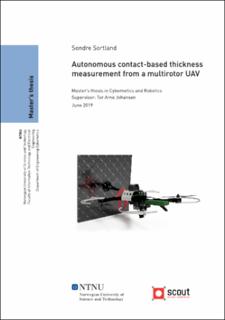| dc.contributor.advisor | Johansen, Tor Arne | |
| dc.contributor.author | Sortland, Sondre | |
| dc.date.accessioned | 2019-10-31T15:11:06Z | |
| dc.date.issued | 2019 | |
| dc.identifier | no.ntnu:inspera:35771502:17383963 | |
| dc.identifier.uri | http://hdl.handle.net/11250/2625729 | |
| dc.description.abstract | Denne avhandlingen undersøker automatiseringen av tykkelsesmålinger ved hjelp av en ultralydssonde montert på en drone. Bruk av ubemannede luftfartøyer (unmanned aerial vehicles (UAVs)) for ikke-destruktiv testing (non-destructive testing (NDT)) i industrielle miljøer har stort potensial for tid- og kostnadsbesparelser. Stor suksess er oppnådd innenfor visuelle inspeksjoner ved hjelp av droner, og nærmer seg helt autonome operasjoner. Nylige fremskritt innen sensorteknologi har gjort det mulig å montere små, lette ultralydsensorer for tykkelsesmåling på ubemannede multikopter. Disse sensorene krever kun sekunder med kontakt for å ta pålitelige målinger, og åpner for muligheten til å gjøre tykkelse målinger fra ubemannede multikopter.
Denne avhandlingen har utviklet modeller og kontrollalgoritmer for kontaktbaserte operasjoner, inspirert av relatert arbeid på emnet. Disse kontrollerne har videre blitt validert ved hjelp av en høyytelses fysikkmotor. Kontrollerne er basert på teori fra kraftkontroll, og tar i bruk rammeverk for impedansbasert kontroll, samt passivitet. Videre er en metode for følging av forhåndsgenererte optimale baner blitt utviklet og testet i samme fysikkmotoroppsett. I tillegg til dette har metoder for lokal navigasjon basert på regresjon og RANSAC på data fra en 2D, roterende LIDAR blitt utviklet og testet.
Videre har komplette scenarier med autonome tykkelsesmålinger blitt testet på flere droneplattformer for industriell inspeksjon. I tillegg til implementeringen av impedanskontrollene nevnt ovenfor inkluderer dette integrering av en ultralydtykkelsesmåler, samt sensorer og metoder for lokal navigasjon.
Resultatene fra både simuleringer i fysikkmotor og utførte eksperimenter viser at kontrollerne opnnår stabil kontakt med omgivelsene, med solid robusthet mot forstyrrelser. Til slutt har kontrollerne og navigasjonsmetodene utviklet i denne oppgaven, sammen med den utførte integrasjonen, vist en fungerende løsning for autonome tykkelsesmålinger. Dette gjør det mulig for inspektører å gjennomføre avanserte inspeksjonsscenarier uten tidligere erfaring eller omfattende pilotopplæring. | |
| dc.description.abstract | This thesis investigates the automation of thickness measurements using an ultrasonic probe mounted on a drone. The use of unmanned aerial vehicles (UAVs) for non-destructive testing (NDT) in industrial environments have great potential for time and cost savings. Great success has been demonstrated in the area of visual inspection using drones, and is moving towards fully autonomous operations. Recent advancements in sensor technology has enabled small, light-weight ultrasonic thickness measurement gauges that can be mounted on small multirotor UAVs. These sensors require only seconds of contact to take reliable measurements, opening for the opportunity to do thickness measurements from multirotor UAVs.
This thesis has developed models and control algorithms for contact based interactions, inspired by related work on the topic. These controllers have further been validated using a high performance physics engine. The controllers are based on theory from force control, utilizing the impedance control framework, together with passivity based control. Furthermore, a method using tracking of pre-computed optimal trajectories have been developed and tested in the same physics engine setup. In addition, methods for local navigation based on data from a 2D scanning LIDAR using regression and RANSAC has been developed and tested.
Furthermore, complete scenarios with autonomous thickness measurements have been tested on multiple drone platforms for industrial inspection. In addition to the implementation of the impedance controllers mentioned above, this includes integration of an ultrasonic thickness measurement gauge, as well as sensors and methods for local navigation.
The results from both simulations in a physics engine and experimental validation shows that the controllers are capable of stable interaction with the environment, with solid robustness against disturbances. In conclusion, the controllers and navigation methods developed in this thesis, along with the integration carried out, have demonstrated a functioning solution for autonomous thickness measurements. This enables inspectors to carry out advanced inspection scenarios without prior experience or extensive pilot training. | |
| dc.language | eng | |
| dc.publisher | NTNU | |
| dc.title | Autonomous contact-based thickness measurement from a multirotor UAV | |
| dc.type | Master thesis | |
